Physical vs. Behavioral Biometrics
A biometric system is used for recognition based on several behavioral or psychological traits of the person under protection by the system. This type of data can be used to identify the legitimate user and assign them an access ID. Biometric access systems are convenient as information carriers are always with the access IDs wherever they are and cannot be fabricated or lost, hence providing a reliable and safer solution even in the face of data breaches.
Biometric credentials like retina scans or fingerprints are almost impossible to hack or breach compared to password and username combinations. Biometrics belong to two major groups, either physical or behavioral scanners, which differ greatly depending on the type of access control they require.
1. Physical biometric readers
Physical or static readers are based on the person’s physiological characteristics in the present and last a lifetime without being changed.
These features include hand, face, iris, and vein pattern identification. Yet such dynamic and combined information security features represent only 20% of the entire biometric market globally, in recent years, there has been active development with more tailored protection methods.
2. Behavioral biometric scanners
This type of biometric security is based on the individual’s behavioral characteristics as they evaluate their unique subconscious movements in reproducing any actions. Simultaneously, suspicious behavior can signal a deviation from the norm and identify them as fraudulent hence denying access. Behavioral readers can be tailored for a wide range of devices, including smartphone operating systems.
It can only be used in individual applications and be used to protect a device from unauthorized access.
Final Thoughts
IDEMIA , world leader of biometric readers market, bring on competition in developing better and safer biometric systems, and provide new applications and opportunities.
Along with the more commonly used hand and fingerprint geometry scanning technologies, more innovative biometric readers, such as iris recognition, are quickly gaining popularity.
For more information about biometric readers and their applications, contact us.






